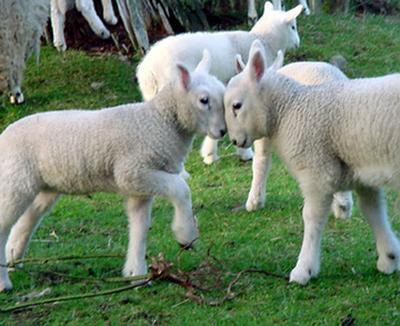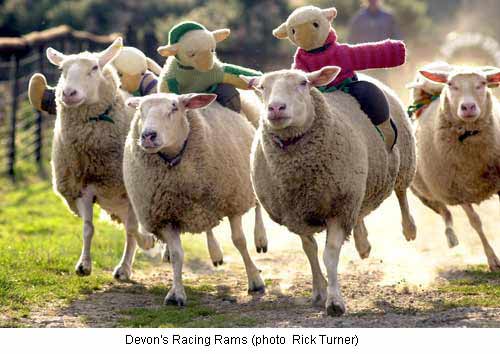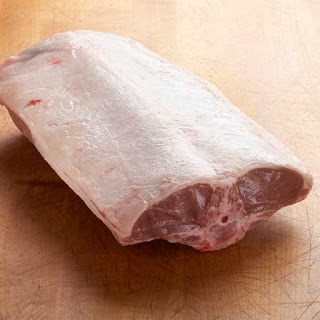A Abomasum The fourth or true digestive part of a ruminant's stomach that contains gastric juices and enzymes that begin the breakdown of complex materials.
Accelerated lambing Breeding a ewe flock to average more than one lamb crop each year, usually three lamb crops in two years.
Acidosis A condition when the rumen becomes too acid. Usually due to over-consumption of grain.
Anestrus The period in which sheep are sexually inactive, usually during spring and summer months.
Animal unit month (AUM) Amount of forage used by an animal unit (one cow and her calf) for one month.
Artificial rearing Raising a lamb on milk or milk replacer.
B
Body condition score A value from 1- 5 (thin to fat)used to estimate condition of an animal.
Bolus A large oval shaped pill containing antibiotics.
Bots Tiny larvae that crawl into nasal passages.
Breeding capacity The number of ewes that a ram can mate and still achieve high fertility within the shortest breeding interval.
Breeding season The period of time when the ewe is showing estrus.
Broken mouth The stage in a sheep's life when teeth begin to fall out.
Browse Broad-leafed woody plant, shrub or bush.
Burdizzo Tool used to castrate lambs by severing the cord without breaking the skin of the scrotum.
Butting Method of fighting among rams by the striking of the head and horns.
C
Calcium to Phosphorus Ratio Relative amounts of calcium and phosphorus in the total ration. Usually recommended to be at least 2:1.
Chlamydia Small organisms associated with pneumonia, abortion, diarrhea, conjunctivitis, arthritis and encephalitis.
Chlamydiosis Type of infectious abortion. The most common abortion disease experienced by the sheep industry.
Clip One season's yield of wool.
Cloning The production of genes or individuals which are genetically the same as the donor.
Clostridial organisms Anaerobic bacteria that produce spores under certain conditions
Coccidiosis Disease in feeder lambs characterized by diarrhea, dehydration, loss of weight and weakness.
Colostrum The first milk produced, rich in antibodies, energy and vitamin A. This protects the lamb from most neonatal diseases for the first six weeks of life.
Coronary band The junction between the hoof wall and the skin above the hoof.
Creep feeding A method of providing supplemental feed for lambs, without access by the dam, during the nursing period.
Critical temperature Maximum or minimum environmental temperature tolerated by the animal before additional dietary energy is required to maintain normal body temperature.
Crossbred The offspring resulting from mating a ram and ewe of different breeds.
Crossbreeding Mating plan involving two or more breeds.
Crutching Shearing of wool from around the dock and udder.
Cryptrosporidiosis An organism that proliferates in the small intestine.
Culling The process of removing animals that are below average in production, unsound or undesirable.
Culls Sheep which are below a required standard.
Custom feeding The practice of having livestock fed and managed for the livestock owner in another facility for a fee.
Cysticercosis The condition where a larval form of a tapeworm has encysted or embedded itself in the tissue of its host.
D
Dam The mother.
Deworming Management practice of administering medication to alleviate internal worms.
Docking Process of removing long tails.
Drenching The oral administration of medication.
Dressing Percentage The carcass weight divided by the live weight.
Drift lambing Each day the ewes that have not lambed are moved to a new pasture and the ewes with newborn lambs are left behind.
Drylot A penned area for holding the flock for an extended period with or without housing.
Dry matter (DM) The portion of feed that is not water.
Dual product Two products marketed from the same animal, wool and meat for sheep.
Dual-purpose breeds Breeds that can be used as ewe or ram breed depending upon production situation.
E
E. coli scours Disease that effects lambs in first 5-7 days of life causing watery, yellow diarrhea, dehydration and rapid death.
Elastrator Instrument used to apply heavy rubber bands (elastrator rings/bands) to tail and scrotum for docking and castration.
Embryo transfer Recently fertilized eggs from donor ewe are transferred to the uterus of a recipient ewe, usually by surgically exposing the uterus of the recipient.
Emaciation To waste away physically.
Emasculator Tool used for docking lambs that has a crushing effect which may result in less bleeding.
Encephalitis Inflammation of the brain usually with severe signs such as fever, incoordination, and convulsions.
Enteritis An inflammation of the intestinal tract.
Enterotoxemia type C Disease that affects lambs in the first two weeks of life causing bloody infection of the small intestine and rapid death.
Enterotoxemia type C and D toxoid Vaccination given to young lambs to build up antibodies against Enterotoxemia type C and D. It is also available combined with tetanus vaccination.
Enterotoxemia type D Disease that affects unvaccinated lambs that have been placed on high energy diets.
Entropion A heritable trait in which the lower eyelid is inverted, causing the eyelashes of the lower lid to brush against the eye.
Esophageal feeder Tube placed down the esophagus of a lamb to administer milk or other liquid.
Estrogen Hormone that causes regression of the corpus luteum and stimulates estrus
Estrous cycle the time period from beginning of one heat to the beginning of the next heat. Usually about 16-17 days.
Estrus The period of time when the female is sexually receptive to the male, Usually 24-36 hours, also known as "heat".
Ewe Female sheep
Ewe breed Usually white faced breeds of fine-wool type developed from crosses of fine and long-wool types and highly prolific breeds.
Extensive management Production system where sheep grave most or all of the year on pastures or range.
External parasite Parasites that may be found on the fleece, skin and in the nasal and ear passages.
F
Facing Correcting wool blindness by removing wool from the face.
Fleece The entire coat of wool shorn from the sheep at one time.
Flight zone Minimum zone of comfort or security of animals.
Flocking instinct Social and behavioral relationship that causes animals to remain as a group.
Flushing Management practice of improving a ewe's plane of nutrition just prior to mating to improve ovulation rate.
Fly strike Blow or bottle flies that are attracted to soiled wool, wounds and dying tissue. Causes myiasis or maggot infestation.
Foot bath Chemical and water mixture, that sheep stand in, used for the prevention and/or treatment of foot rot and foot scald.
Forage Fiber-containing feedstuffs such as silage, hay and pasture.
Forcing pen Pen used to confine animals prior to moving them into treatment chutes.
G
Gambrel restrainer Restraining device that is a gambrel-shaped piece of plastic that is placed over the top of the animal's neck, with slots on either side to hold both front legs of the animal.
Gastroenteritis An inflammation of the stomach and intestines
Gathering pen Fenced pen that will comfortably hold the largest number of sheep you expect to work at one time.
Gestation Period of pregnancy beginning at conception and ending with birth (142-152 days).
Grafting Fostering a lamb onto a ewe that is not its natural mother.
Group-fed Feeding system where all animals in a group are fed at one time.
Guard dog A dog that stays with the sheep without harming them and aggressively repels predators.
Gummer Stage in a sheep's life when they have no teeth at all.
H
HACCP Hazard Analysis Critical Control Point, an internationally recognized and recommended approach to food safety that anticipates and prevents hazards associated with ingredients.
Hand-fed The producer limits the feed animals have access to.
Haylage Ensiled forage crop about 50% dry matter.
Herbivore Animals that consume primarily grass and other plant material.
Heterosis Hybrid Vigor. Superiority of a crossbred individual relative to the average performance of purebred parents included in the cross.
Holding pen A pen that is filled as sheep are sorted
Hot irons Tool used to dock lambs that cuts and cauterizes the tail. When properly used there is little bleeding and little chance for infection.
Hybrid Vigor (HV) Heterosis. Superiority of a crossbred individual relative to the average performance of purebred parents included in the cross.
Hydatitosis Cysts found in the body cavity of sheep.
Hypocalcemia Low levels of calcium in the blood.
Hypomagnesemia Low levels of magnesium in the blood.
Hypothermia Inability to keep warm often caused by cold or wet weather.
I
Intensive Management Production system where sheep are fed harvested feed thus requiring higher levels of management and facilities.
Intermediate host An animal or other living body in which a parasite completes part of its life cycle and usually causes no damage.
Internal parasites Parasites located in the stomach and intestines of sheep.
International unit (IU) Unit of measurement of vitamins and drugs.
Intramuscular injection (IM) An injection into heavy muscle tissue.
Intravenous injection (IV) An injection directly into the bloodstream. Iodine Disinfectant used on navels of newborn lambs that helps dry up the navel, thus closing the passageway into the body of the lamb. Veterinary iodine contains 7% iodine while common iodine for humans contains 2% iodine.
J
Joint ill Infected joints, also called Erysipelas.
K
Keds Bloodsucking ticks that pierce the skin causing serious damage to the pelts.
Ketones Compounds found in the blood of pregnant sheep suffering from pregnancy toxemia
Known carrier An animal that has produced offspring with a genetic defect.
L
Lactation The period when ewe is producing milk. Normally from birth of lamb to weaning.
Lamb coat graft A grafting method in which the pelt skinned from a dead lamb is tied to a lamb to be grafted.
Lambing pens (jug) Small pens (4'x4' or larger) that lambs and ewes are placed in for a short time after the lambs are born.
Lanolin Purified wool grease.
Legumes Family of plants bearing seeds in a pod.
Limit-fed Feeding animals less than they normally consume.
Linebreeding Use of close relatives such as sons or grandsons in a breeding program to retain merits of an ancestor.
Liver flukes Small leaf-shaped organisms that rolls up like a scroll in the bile ducts or liver tissue.
Loading chute A chute used for loading animals into a truck or trailer.
Lungworms Roundworms found in the respiratory tract and lung tissue.
M
Maintenance Stage in production cycle when the ewe neither gains nor loses weight or condition.
Mange mites Mites which infest and damage the skin and wool.
Marking harness A harness containing a coloured marker that is placed on the ram during the breeding season to determine cycling activity of ewe flock, monitor the breeding activity of the ram, and predict lambing dates.
Mastitis Inflammation of the mammary gland caused by bacterial infection, resulting in reduced milk production.
Mating capacity The number of ewes that a ram can mate and still achieve high fertility.
Milk replacer Artificial milk substitute fed to young lambs.
Mineral Inorganic substance found naturally in all body cells, tissues and fluids.
Mutton The meat of an older sheep.
N
Natural immunity Inherited resistance to disease that varies between breeds, strains within breeds and individuals.
Necropsy Examination of a dead animal to determine cause of death.
Nitrate poisoning Condition in which toxic levels of nitrates accumulate in plants.
Nose bots Tiny larvae that crawl into nasal passages.
O
Omasum The third part of a ruminant stomach located between the reticulum and the abomasum.
Oocyst A stage in the life cycle of coccidia (a protozoal parasite) that is shed in manure . Sheep become infected by ingesting oocysts from contaminated pastures.
Out of season lambing The act of producing lambs in the summer or fall.
Over the counter drugs (OTC) Drugs that can be purchased directly by the producer.
P
Parasite An organism that lives off of a host.
Pelt The skin of a sheep including the wool.
Pinkeye A highly contagious disease that effects the eyes of sheep.
Pregnancy toxemia A metabolic disease of pregnant ewes generally caused by diet deficient in energy during late pregnancy.
Prescription drugs Drugs that can only be purchased after authorization by a veterinarian.
Protein Nitrogen-based essential nutrient, composed of chains of amino acids, that is present in all living things.
Protein supplement Feedstuff that contain a high level of protein. Fed to animals in addition to their base diet.
R
Ram A male sheep.
Ram breed Meat-type breeds used primarily as terminal sires on ewe or dual-purpose breeds for market lamb production.
Ram test A facility where rams from many flocks are raised together for a short period and compared under standardized conditions.
Ram to ewe ratio The number of rams that it takes to service a group of ewes.
Ration A mixture of feedstuffs fed to animals
Reticulo-rumen Section of the ruminant gastrointestinal tract consisting of the reticulum and the rumen that is the primary site for microbial fermentation of feedstuffs.
Rotational breeding System that places rams with breeding flock for set, predetermined periods of time.
Roughage Coarse, bulky feed high in fiber such as hay, straw and silage.
Rumen The large first compartment of a ruminant's stomach containing microbial population that is capable of breaking down forages and roughages.
Rumen-reticulum Pregastric fermentation chamber that host a large microbial population.
Ruminant A group of animals that chew thew their cud and characteristically have a four compartment stomach.
Rumination The process of regurgitating food to be rechewed.
S
Salmonellosis Serious disease of feeder lambs characterized by gastroenteritis, diarrhea, septicemia and death.
Scours Diarrhea
Scarpie Slow. progressive disease of the central nervous system.
Self-fed Feeding process where animals have access to feed at all times.
Septicemia A bacterial infection of the blood stream that spreads throughout the body.
Shearing The removing of wool from sheep.
Shrink The loss of body weight associated with transporting animals or carcasses during marketing.
Silage Green forage converted to a succulent feed of 30%-40% dry matter for sheep by storing without air (as in silo or air-tight bags).
Sire The father
Sire breed Breed noted for high levels of performance for growth rate, feed efficiency, or carcass merit.
Slime graft A grafting method in which the ewe's fluids and membranes are rubbed on the lamb just before grafting.
Soremouth A highly contagious (also to humans), viral infection that causes scabs around mouth, nostrils, eyes and may effect udders of lactating ewes.
Stanchion graft A grafting method in which the ewe is placed in a set stocks where she can eat and drink but not turn to see the lambs and must allow lambs to nurse.
STAR system An accelerated lambing system in which ewes can lamb 5 times in 3 years.
Stocking graft A grafting method in which a stocking is placed over a ewe's lamb for 2 to 3 days, removed and placed on lamb to be grafted
Stocking rate The number of animals grazed on an acre.
Strip grazing An intensified system of rotational grazing in which pasture is grazed in strips.
Subcutaneous injection (SQ) An injection given just below the skin.
Synchronization A management practice used to cause the ewes to cycle at the same time.
Systemic disease A disease where more than one portion of the body is affected; often the whole body or one or more systems.
T
Tagging The practice of shearing wool on udder and dock region.
Tapeworms Long, ribbon-like segmented flatworms that can inhabit the gastro-intestinal tract of animals.
Terminal sire A ram whose lambs all go to market as slaughter lambs.
Ticks Wingless bloodsucking insects that infest during the summer.
Total digestible nutrients (TDN) Standard system for expressing the energy value of feeds.
Trace minerals (TM) Minerals that are required in very small amounts.
U
Urinary calculi Metabolic disease of male lambs characterized by the formation of stones within the urinary tract. It is caused primarily by an imbalance of dietary calcium and phosphorus.
V
Vaccination Injection, given to healthy animals, used to stimulate prolonged immunity to specific diseases.
Vaginal prolapse Protrusion of the vagina in ewes in late pregnancy.
Vitamins Small organic compounds, necessary for proper metabolism, that are found in feed in minute amounts. Deficiencies result in distinct diseases or syndromes.
W
Wet graft A grafting method in which the lamb to be grafted as well as the ewe's own lamb is immersed in a saturated salt solution.
Wether A castrated male sheep.
White muscle disease A disease caused by a deficiency of selenium, Vitamin E or both that causes degeneration of skeletal and cardiac muscles of lambs.
Wool The fibrous covering of the sheep.
Y
Yearling A one year old sheep.















